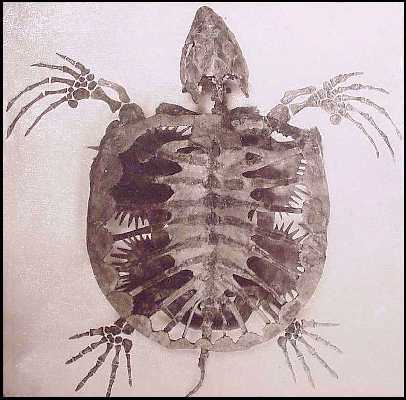FOSSIL-COLLECTOR’S EXPERIENCES.
BY
CHARLES H.
STERNBERG.
I met with one experience in the Chalk of western Kansas, last
August, that I shall not soon forget. I had some pleasure in looking for the first time
upon a perfect skeleton of a very rare animal, that once lived in the Cretaceous ocean. My
great sorrow was that I could not save it in the condition in which I found it, to grace
the museum of one of our large universities, where it would have been cared for and highly
prized. -
It
was, I believe, the only perfect skeleton ever seen by anyone, except myself, and those
few persons who chanced to pass, when I had, after several days, succeeded in brushing off
the loose chalk and impure gypsum in which it was entombed.
I bad no
camera and am not an artist, or I could have given great pleasure to many authorities in
paleontology by picturing it as it lay exposed to the but sun, which had not looked down
upon it for millions of years, since, full of life and motion, it was the “boatman of
the Cretaceous ocean,” now known to science as Cope’s Protostega gigas,
“the first great roof,”—The largest of all sea turtles.
This was a
perfect skeleton, lying in a low wash in Gove County, Kan., only a few inches below the
surface in material that had become disintegrated, and in which the peculiar shrub that
lives in the chalk and shale beds, had been living in luxury, covering the bones with a
compact mess of rootlets, eating up the hard outer surface, and would eventually have
entirely consumed it, had I not happened along to tear them away. To add to my sorrows,
the bones themselves bad been broken to pieces by the uplift of the strata, and were
covered with a thin layer of blue clay, that also filled the cracks; this acted like
mortar. It could not be brushed off without bringing up fragments, and it prevented
me from covering the bones in sections with starched paper, or cloth, to strengthen and
hold the fragments in place, so they could be taken up, restored and mended in the
laboratory, as the damp starch would have loosened the clay and left the bones behind.
For hours, I thought of
every conceivable plan I could adopt to save the skeleton entire, as I had uncovered it,
but had to give it up, and took up several hundred pounds of fragments, that will require
the patience of Job and great skill to restore the skeleton more or less complete.
|
The animal lay down to die in its natural position. The carapace was slightly shoved by
pressure a little out of line by rough measurement it was 8 feet from end of snout to the
end of tail, and 6 feet between the marginal bones in their widest part. Bearing in mind
that I am not an anatomist but a collector, and have had no time to study the structure in
detail of the thousands of fossil animals I have collected, I will give as perfect a
description as possible for me, of this famous turtle.
The
carapace seemed to consist of wedge-shaped elements, along the central axis, which were
joined by sutures at either end and from which radiated (except in the center, where they
were at right angles), 8 pairs of rib-like bodies, broad and compressed, and united by
sutures for several inches and then rapidly narrowed to a rib two inches wide, which
projected free to the marginal plates. The central rib, from the middle, both ways of the
carapace, was nearly three feet long. The marginal bones were small with thick outer lips,
and by their beautiful sutures appeared to be joined to the great plates of the plastron,
of which there were four large ones, an inch thick in the center, beveled off to a thin
edge with long finger-like projections to fit in their fellows and the marginal bones.
Joined to these four great
plates were two in front and two behind, with outer edges thick end curved, to allow the
passage of The four powerful limbs, or paddles, and the neck and head in front and tail
behind. The paddles ended in long claw bones, or ungual phalanges. The skull was large.
This, in brief, is what I
saw that hot August day: and I have now in my workshop the fragments I was able to save,
dreading to go to work on it, as, though many good bones can be restored, I know the
careful tedious work necessary even to do that; and I never (nor can any one) mount it for
one of our universities as I saw it in its burial place in western Kansas.
The above was written a
year ago. In last June number, under the title “The First
Great Roof,” appears a later article, showing the remarkable progress I am making
in the restoration of this must wonderful of all sea-tortoises. I now believe the skeleton
can he nearly restored.
|

